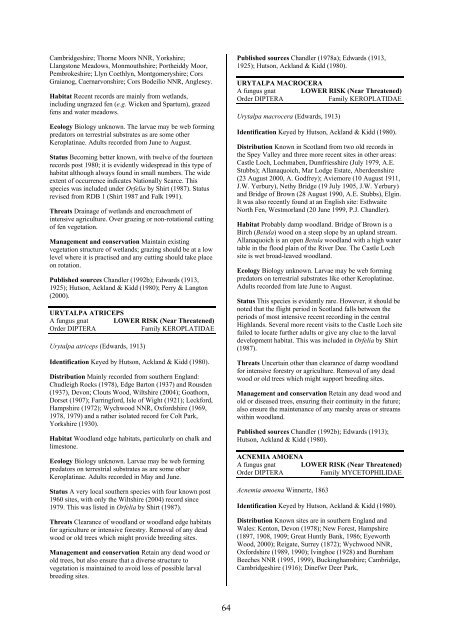Part 2: Nematocera and Aschiza not dealt with by Falk (1991) - JNCC
Part 2: Nematocera and Aschiza not dealt with by Falk (1991) - JNCC
Part 2: Nematocera and Aschiza not dealt with by Falk (1991) - JNCC
You also want an ePaper? Increase the reach of your titles
YUMPU automatically turns print PDFs into web optimized ePapers that Google loves.
Cambridgeshire; Thorne Moors NNR, Yorkshire;<br />
Llangstone Meadows, Monmouthshire; Portheiddy Moor,<br />
Pembrokeshire; Llyn Coethlyn, Montgomeryshire; Cors<br />
Graianog, Caernarvonshire; Cors Bodeilio NNR, Anglesey.<br />
Habitat Recent records are mainly from wetl<strong>and</strong>s,<br />
including ungrazed fen (e.g. Wicken <strong>and</strong> Spartum), grazed<br />
fens <strong>and</strong> water meadows.<br />
Ecology Biology unknown. The larvae may be web forming<br />
predators on terrestrial substrates as are some other<br />
Keroplatinae. Adults recorded from June to August.<br />
Status Becoming better known, <strong>with</strong> twelve of the fourteen<br />
records post 1980; it is evidently widespread in this type of<br />
habitat although always found in small numbers. The wide<br />
extent of occurrence indicates Nationally Scarce. This<br />
species was included under Orfelia <strong>by</strong> Shirt (1987). Status<br />
revised from RDB 1 (Shirt 1987 <strong>and</strong> <strong>Falk</strong> <strong>1991</strong>).<br />
Threats Drainage of wetl<strong>and</strong>s <strong>and</strong> encroachment of<br />
intensive agriculture. Over grazing or non-rotational cutting<br />
of fen vegetation.<br />
Management <strong>and</strong> conservation Maintain existing<br />
vegetation structure of wetl<strong>and</strong>s; grazing should be at a low<br />
level where it is practised <strong>and</strong> any cutting should take place<br />
on rotation.<br />
Published sources Ch<strong>and</strong>ler (1992b); Edwards (1913,<br />
1925); Hutson, Ackl<strong>and</strong> & Kidd (1980); Perry & Langton<br />
(2000).<br />
URYTALPA ATRICEPS<br />
A fungus gnat LOWER RISK (Near Threatened)<br />
Order DIPTERA<br />
Family KEROPLATIDAE<br />
Urytalpa atriceps (Edwards, 1913)<br />
Identification Keyed <strong>by</strong> Hutson, Ackl<strong>and</strong> & Kidd (1980).<br />
Distribution Mainly recorded from southern Engl<strong>and</strong>:<br />
Chudleigh Rocks (1978), Edge Barton (1937) <strong>and</strong> Rousden<br />
(1937), Devon; Clouts Wood, Wiltshire (2004); Goathorn,<br />
Dorset (1907); Farringford, Isle of Wight (1921); Leckford,<br />
Hampshire (1972); Wychwood NNR, Oxfordshire (1969,<br />
1978, 1979) <strong>and</strong> a rather isolated record for Colt Park,<br />
Yorkshire (1930).<br />
Habitat Woodl<strong>and</strong> edge habitats, particularly on chalk <strong>and</strong><br />
limestone.<br />
Ecology Biology unknown. Larvae may be web forming<br />
predators on terrestrial substrates as are some other<br />
Keroplatinae. Adults recorded in May <strong>and</strong> June.<br />
Status A very local southern species <strong>with</strong> four known post<br />
1960 sites, <strong>with</strong> only the Wiltshire (2004) record since<br />
1979. This was listed in Orfelia <strong>by</strong> Shirt (1987).<br />
Threats Clearance of woodl<strong>and</strong> or woodl<strong>and</strong> edge habitats<br />
for agriculture or intensive forestry. Removal of any dead<br />
wood or old trees which might provide breeding sites.<br />
Management <strong>and</strong> conservation Retain any dead wood or<br />
old trees, but also ensure that a diverse structure to<br />
vegetation is maintained to avoid loss of possible larval<br />
breeding sites.<br />
Published sources Ch<strong>and</strong>ler (1978a); Edwards (1913,<br />
1925); Hutson, Ackl<strong>and</strong> & Kidd (1980).<br />
URYTALPA MACROCERA<br />
A fungus gnat LOWER RISK (Near Threatened)<br />
Order DIPTERA<br />
Family KEROPLATIDAE<br />
Urytalpa macrocera (Edwards, 1913)<br />
Identification Keyed <strong>by</strong> Hutson, Ackl<strong>and</strong> & Kidd (1980).<br />
Distribution Known in Scotl<strong>and</strong> from two old records in<br />
the Spey Valley <strong>and</strong> three more recent sites in other areas:<br />
Castle Loch, Lochmaben, Dumfriesshire (July 1979, A.E.<br />
Stubbs); Allanaquoich, Mar Lodge Estate, Aberdeenshire<br />
(23 August 2000, A. Godfrey); Aviemore (10 August 1911,<br />
J.W. Yerbury), Nethy Bridge (19 July 1905, J.W. Yerbury)<br />
<strong>and</strong> Bridge of Brown (28 August 1990, A.E. Stubbs), Elgin.<br />
It was also recently found at an English site: Esthwaite<br />
North Fen, Westmorl<strong>and</strong> (20 June 1999, P.J. Ch<strong>and</strong>ler).<br />
Habitat Probably damp woodl<strong>and</strong>. Bridge of Brown is a<br />
Birch (Betula) wood on a steep slope <strong>by</strong> an upl<strong>and</strong> stream.<br />
Allanaquoich is an open Betula woodl<strong>and</strong> <strong>with</strong> a high water<br />
table in the flood plain of the River Dee. The Castle Loch<br />
site is wet broad-leaved woodl<strong>and</strong>.<br />
Ecology Biology unknown. Larvae may be web forming<br />
predators on terrestrial substrates like other Keroplatinae.<br />
Adults recorded from late June to August.<br />
Status This species is evidently rare. However, it should be<br />
<strong>not</strong>ed that the flight period in Scotl<strong>and</strong> falls between the<br />
periods of most intensive recent recording in the central<br />
Highl<strong>and</strong>s. Several more recent visits to the Castle Loch site<br />
failed to locate further adults or give any clue to the larval<br />
development habitat. This was included in Orfelia <strong>by</strong> Shirt<br />
(1987).<br />
Threats Uncertain other than clearance of damp woodl<strong>and</strong><br />
for intensive forestry or agriculture. Removal of any dead<br />
wood or old trees which might support breeding sites.<br />
Management <strong>and</strong> conservation Retain any dead wood <strong>and</strong><br />
old or diseased trees, ensuring their continuity in the future;<br />
also ensure the maintenance of any marshy areas or streams<br />
<strong>with</strong>in woodl<strong>and</strong>.<br />
Published sources Ch<strong>and</strong>ler (1992b); Edwards (1913);<br />
Hutson, Ackl<strong>and</strong> & Kidd (1980).<br />
ACNEMIA AMOENA<br />
A fungus gnat LOWER RISK (Near Threatened)<br />
Order DIPTERA<br />
Family MYCETOPHILIDAE<br />
Acnemia amoena Winnertz, 1863<br />
Identification Keyed <strong>by</strong> Hutson, Ackl<strong>and</strong> & Kidd (1980).<br />
Distribution Known sites are in southern Engl<strong>and</strong> <strong>and</strong><br />
Wales: Kenton, Devon (1978); New Forest, Hampshire<br />
(1897, 1908, 1909; Great Huntly Bank, 1986; Eyeworth<br />
Wood, 2000); Reigate, Surrey (1872); Wychwood NNR,<br />
Oxfordshire (1989, 1990); Ivinghoe (1928) <strong>and</strong> Burnham<br />
Beeches NNR (1995, 1999), Buckinghamshire; Cambridge,<br />
Cambridgeshire (1916); Dinefwr Deer Park,<br />
64
















